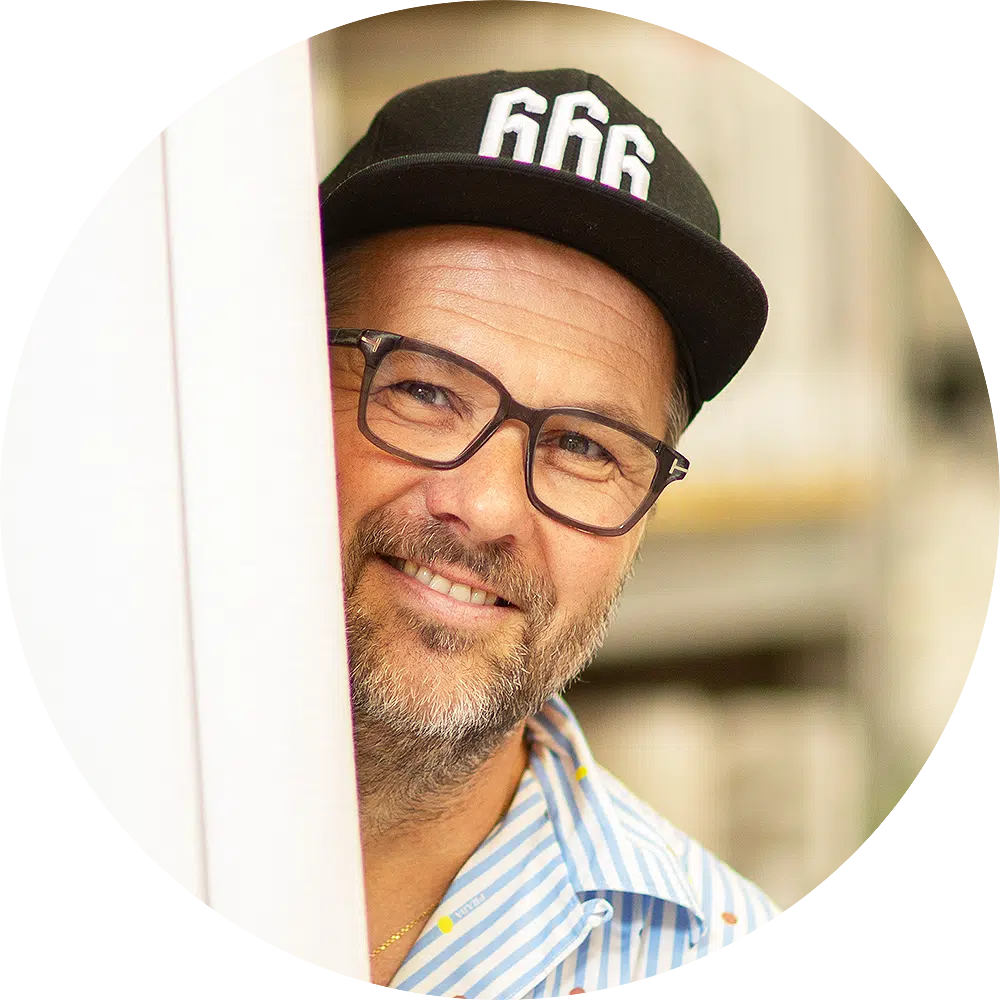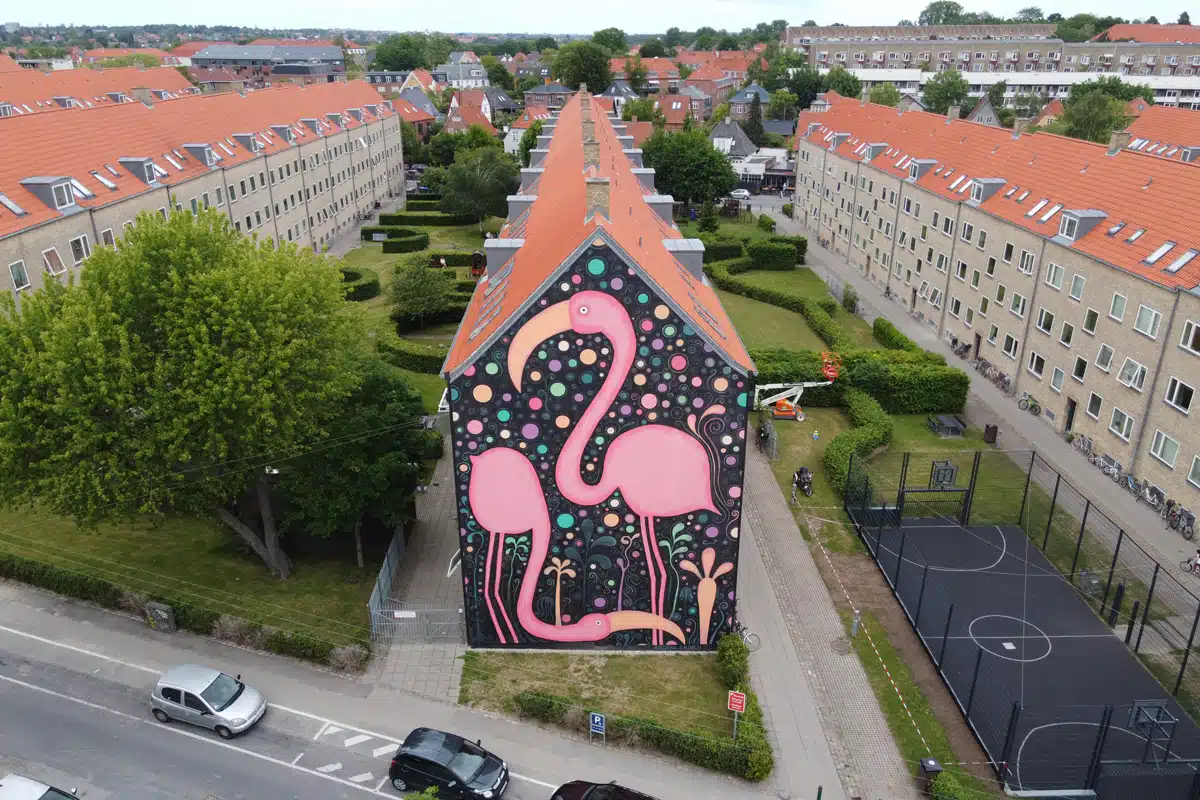
Photo: Theis Mortensen
Street Art Aims to Contribute to the World: Interview with Jens-Peter Brask
By Maj Schubert
November 17, 2023
He started doing graffiti in 1986, partly because it was more fun than playing table tennis or soccer. But also because graffiti culture was a form of rebellion. Today, he spends most of his time finding visual artists who create huge, colorful works on gray gables throughout Copenhagen. In this interview, Jens-Peter Brask explains what graffiti and street art does to the city – and why these two urban decorations are entirely different things.
Both graffiti and street art play a significant role in Copenhagen’s urban space. But what is the difference between what graffiti and street art does to its surroundings?
“Graffiti only speaks to its own world, and graffiti artists only to each other. It’s a very closed community, completely indifferent to others. In graffiti culture, it’s about becoming the king, and there can only be one king. The significant difference is that street art speaks to all of us who experience it in public spaces. It aims to contribute and give something to the surrounding world. The ultimate task of street art is to teach us something and offer us free art to the extent we wish to spend time on it – whether we want to stop and take pictures, or just walk by. You’re not forced to set aside time for it, like when you queue for art in a museum. And if you bike past a piece, and it’s raining, your cap is down, and you look from a different angle than usual, you experience something new. Street art is more straightforward than in galleries. It’s more accessible, art on people’s own terms. And in this way, urban art differs from graffiti, which is about breaking rules and provoking. About taking up space.”
How do you choose buildings for the murals you curate?
“The more creative the choice of buildings, the more exciting it is for us and the artist, so it doesn’t just have to be a gable; it can be all sorts of facades. Ideally it should be a well-situated building. If the building is in a courtyard where no one sees it, it’s only interesting for the residents of that block. It should preferably be a place that attracts attention and benefits many people.”
Is the architecture itself important to you, or do you see it more as a blank canvas?
“It’s very important in its own right, and it’s fascinating to see how architecture constantly evolves. A lot is happening today, and we’ve gotten much better at building and integrating architecture as part of a whole, instead of just slapping something together and putting it up without thinking about the neighborhood and context. Things and areas need to fit together well. And the murals should align with the overall picture.”
Do you think street art like murals can enhance architecture, or are they separate things?
“I think they go well together, but does street art improve architecture? I don’t think so. But they speak well together and can contribute to each other in a good way.”
Do you consider what the architect behind the building would say about the works?
“No. Not at all, it doesn’t interest me.”

Jens-Peter Brask (b. 1972) is a curator, art collector, and publisher. He has curated exhibitions domestically and internationally, published several books about artists and their work, and has one of Denmark’s largest art collections, often referencing graffiti and street art. Today, he works with his company, Curated by Jens-Peter Brask, continuously adding art to the urban landscape and has so far initiated about 58 public artworks throughout Copenhagen. Before art became his full-time occupation, he was an entrepreneur – as a restaurateur and nightclub owner.
Which project are you most proud of?
“It’s the project we did with 16 murals on Rentemestervej in Copenhagen’s Nordvest neighborhood with 16 unique paintings, which have aesthetically lifted the entire area. They have also made it a destination that people from all over Europe travel to see and talk about. And people living in the different buildings talk about them: ‘I live in the one with the circus, the one with the dog, or the one with the flamingos.’ So we have added something entirely new to Nordvest, which used to be more dodgy. Today, so many people visit, look around, take pictures, and become part of the area. Right there, you can really say that something good has been added. And, with all due respect, there’s also been a facelift to the somewhat dull gables from before we started the project.”
Have you encountered critical voices opposing the decorations?
“Fortunately, we all have different tastes. There have been some who have had questions about the work. Art creates dialogue, so that in way we’ve already begun the conversation. In 9 out of 10 cases, we’ve spoken with people who left with a greater understanding of the murals and the choice of them for the area.”
What ethical considerations do you have regarding filling the city with art?
“Naturally, there’s no political art or hidden messages, and nothing that can offend religions. It’s important that things are done properly because it should be something positive in relation to the surrounding society.”
A lot of people can’t stand graffiti and associate it with something illegal. Do you still think there should be room for it?
“I still think that graffiti should be in the cityscape, but naturally, I respect that you can’t just paint on things that isn’t yours. And it can also be annoying if you don’t like graffiti and see it on a train or a wall where it’s illegal. Fortunately, there are some legal places around, which I continuously help find more of. So maybe the artwork will stay for half a day, and then it’s painted over, because the legal places are few and in demand.”
Is there a limit to how much the city’s architecture should be decorated?
“I think so, and we shouldn’t cover the whole city with things. Of course, it must be done at a reasonable level, so it’s not just plastered everywhere and on all buildings. It’s also about whether it’s street art or graffiti, how the effect is, but both need to find a natural spot along with the architecture.”
You talk about sharing art on the street with many. Can it also become too much, can street art become overexposed?
“Both yes and no. For me, street art can be like a secret friend. By that, I mean that you can have found a piece that you don’t necessarily share with everyone else, because then it might get over-posted on the internet. By keeping it secret, you can dive in and out of this work at your own pace. You can certainly take a picture, post it or something, where you share it, but you can also keep it entirely to yourself – like a secret friend you visit occasionally.”

Graffiti, Street Art, and Curated Art in the Urban Landscape
Graffiti started as a subculture in 1960s New York and made its way to Denmark in the 80s. It is largely word-based and is about communicating internally in the graffiti environment. It is found on trains, walls, gables, poles, and facades throughout Copenhagen. Graffiti is more of a culture about filling rather than beautifully decorating the city. The 3 types of graffiti often seen are:
- Tags: A kind of autograph by the graffiti artist in a simple style with one color and quick to make.
- Throw-ups: Letters that are colored and larger than tags, but still quick to execute.
- Pieces: Artistic expressions with multiple colors, details, and more time consuming.
Street art is often motif-based and has a more artistic, aesthetic aim than graffiti, and it is often painted with brushes instead of spray cans. Street art can range from affixed, painted wooden pieces on a wall to massive murals that take many hours to paint. ZUSA, found in many places in Copenhagen, is one example of street art, and another is the many murals Jens-Peter Brask has curated.


